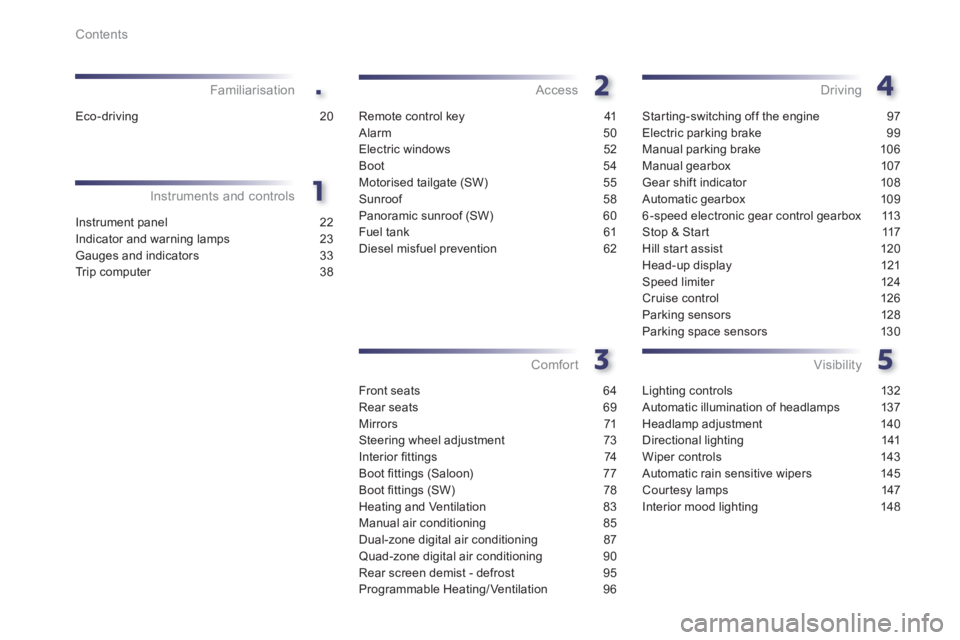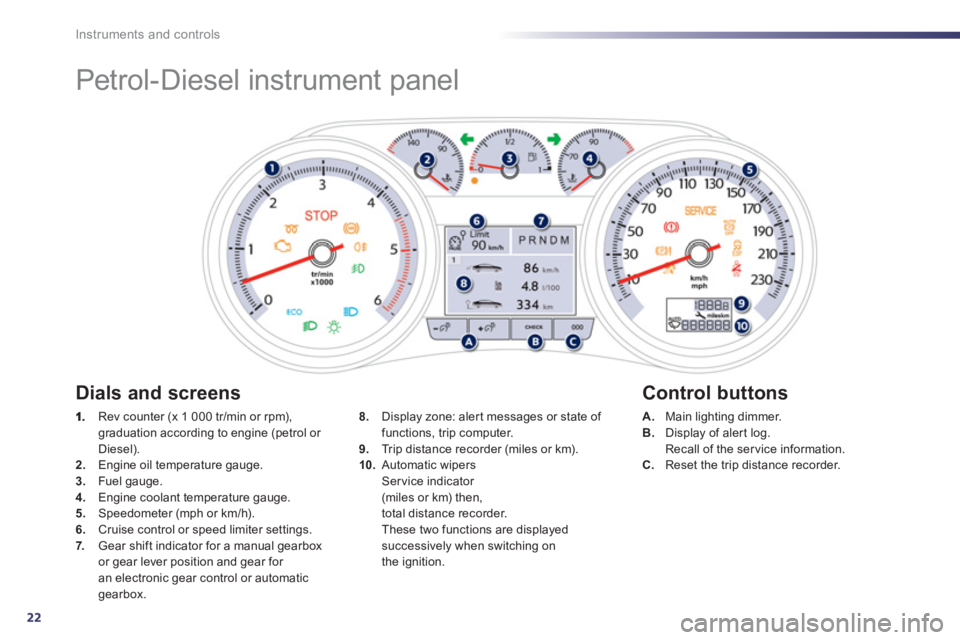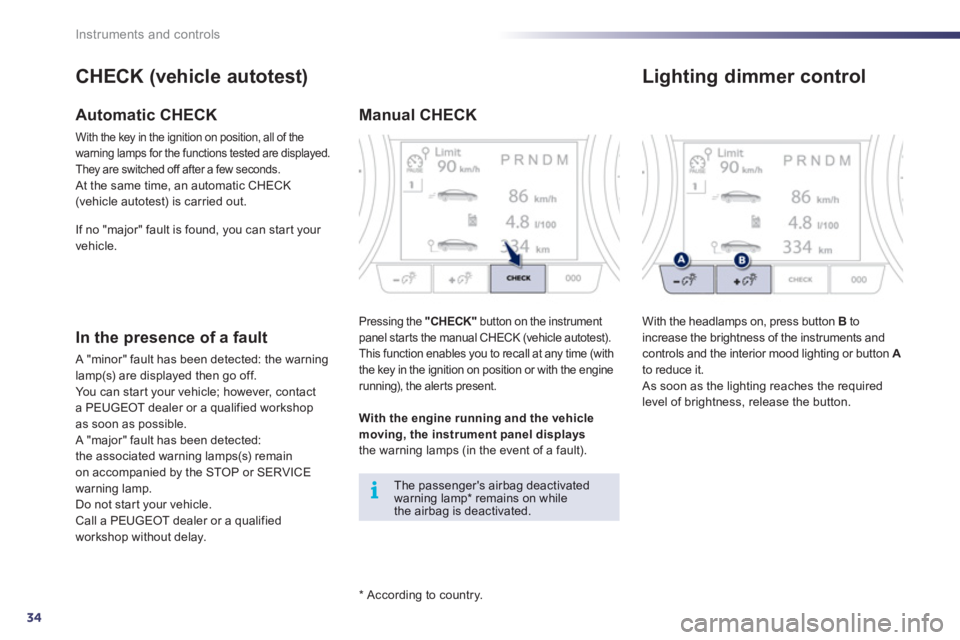display Peugeot 508 2012 Owner's Manual
[x] Cancel search | Manufacturer: PEUGEOT, Model Year: 2012, Model line: 508, Model: Peugeot 508 2012Pages: 340, PDF Size: 11.11 MB
Page 4 of 340

.
Contents
Instrument panel 22
Indicator and warning lamps 23
Gauges and indicators 33
Tr ip computer 38
Instruments and controlsFamiliarisation
Remote control key 41
Alarm 50
Electric windows 52
Boot 54
Motorised tailgate (SW) 55
Sunroof 58
Panoramic sunroof (SW) 60
Fuel tank 61
Diesel misfuel prevention 62
Access
Front seats 64
Rear seats 69
Mirrors 71
Steering wheel adjustment 73
Interior fi ttings 74
Boot fi ttin
gs (Saloon) 77
Boot fi ttings (SW) 78
Heating and Ventilation 83
Manual air conditioning 85
Dual-zone digital air conditioning 87
Quad-zone digital air conditioning 90
Rear screen demist - defrost 95
Programmable Heating/Ventilation 96
Comfort
Starting-switching off the engine 97
Electric parking brake 99
Manual parking brake 106
Manual gearbox 107
Gear shift indicator 108
Automatic gearbox 109
6-speed electronic gear control gearbox 113
Stop & Star t 117
Hill start assist 120
Head-up display 121
Speed limiter 124
Cruise control 126
Parking sensors 128
Parking space sensors 130
Driving
Lighting controls 132
Automatic illumination of headlamps 137
Headlamp adjustment 140
Directional lighting 141
Wiper controls 143
Automatic rain sensitive wipers 145
Cour tesy lamps 147
Interior mood lighting 148
Visibility
Eco-driving 20
Page 9 of 340

.
7
Familiarisation
Interior
Interior mood lighting
This subdued passenger compar tment lighting
improves visibility inside the vehicle in low
lighting conditions.
Head-up display
This system projects speed and cruise control/speed limiter information onto a smoked strip
in the driver's field of vision, so that they do not need to take their eyes off the road.
Digital air conditioning
After setting the desired level of comfor t, the system then automatically controls this level
according to the ambient conditions.
Manual
Audio and communication
systems
These systems benefit from the latest
technology: MP3 compatible audio systems,
USB player, Bluetooth hands-free system,
satellite navigation system with colour screen,
auxiliary inputs, Hi-Fi audio system, ...
Peugeot Connect Navigation (RT6)
14
8
121
85
293 239
Audio system
87
90
Dual-zone
Quad-zone
If your 508 is fitted with a JBLHi-Fi audio system, this is
designed specifically for thepassenger compartment of your
vehicle.
Page 10 of 340

8
Familiarisation
Lighting of the indicator lamp indicates the state
of the corresponding function.
Switch panels
Opening the boot.
Opening the fuel filler flap. 54, 55
Massa
ge.
6
8
50
Alarm.
Pro
grammable heating warning lamp.
6
1
96
Electric parking brake.
99
Starting/stopping using the electronic key.
97
Deactivation o
f Stop & Start.
118
Head-up display (on/off, settings).
12
1
Deactivation of parking sensors.
129
Parkin
g space sensor.
130
Electric child lock.
160
Deactivation o
f the DSC/ASR system.
166
Adaptive lighting.
138
Page 21 of 340

.
19
Familiarisation
Driving safely
1.
Selecting speed limiter mode.2.Decrease the programmed value.3.Increase the programmed value.4.
Pause/resume speed limiter.
5. Speed limiter off.
Speed limiter "LIMIT"
1241
.Selecting cruise control mode.
2. Decrease the programmed value. 3.
Increase the programmed value. 4.
Pause/resume cruise control.
5. Cruise control Off.
Cruise control "CRUISE"
126
The cruise control or speed limiter mode
appears in the instrument panel when it is
selected.
Display in the instrument panel
Cruise control
S
peed limiter
The values must be set with the engine running. In order to be programmed or activated,
the vehicle speed must be higher than 25 mph (40 km/h), with at least 4th gear engaged on a manual gearbox (2nd gear on an electronicgear control or automatic gearbox).
Page 22 of 340

20
Optimise the use of your
gearbox
With a manual gearbox, move off gently,change up without waiting and drive by changing up quite soon. If your vehicle has the system, the gear shift indicator invites youto change up; it is displayed in the instrumentpanel, follow its instructions.
With an automatic or electronic gearbox, stay in Drive "D"or Auto "A" , according to the type of gearbox, without pressing theaccelerator pedal heavily or suddenly.
Drive smoothly
Maintain a safe distance between vehicles,use engine braking rather than thebrake pedal, and press the accelerator progressively. These practices contributetowards a reduction in fuel consumption andCO2emissions and also helps reduce thebackground traffic noise.
If your vehicle has cruise control, make useof the system at speeds above 25 mph (40 km/h) when the traffic is flowing well.
Control the use of your electrical equipment
Before moving off, if the passenger compartment is too warm, ventilate it byopening the windows and air vents before using the air conditioning.
Above 30 mph (50 km/h), close the windows and leave the air vents open.
Remember to make use of equipment that canhelp keep the temperature in the passenger compartment down (sun roof and windowblinds...).
Switch off the air conditioning, unless it has automatic digital regulation, as soon as thedesired temperature is attained. Switch off the demisting and defrostingcontrols, if not automatic. Switch off the heated seat as soon as possible.
Switch off the headlamps and front foglamps when the level of light does not require their use.
Avoid running the engine before moving off,
particularly in winter; your vehicle will warmup much faster while driving.
As a passenger, if you avoid connecting your multimedia devices (film, music, videogame...), you will contribute towards limitingthe consumption of electrical energy, and soof fuel.
Disconnect your por table devices beforeleaving the vehicle.
Eco-driving Eco-driving is a range of everyday practices that allow the motorist to optimise their fuel consumption and CO2emissions.
Page 24 of 340

22
Instruments and controls
Petrol-Diesel instrument panel
Rev counter (x 1 000 tr/min or rpm), graduation according to engine (petrol or Diesel).2.
Engine oil temperature gauge. 3.Fuel gauge.4.
Engine coolant temperature gauge. 5.
Speedometer (mph or km/h).
6.Cruise control or speed limiter settings.
7. Gear shift indicator for a manual gearbox
or gear lever position and gear for an electronic gear control or automatic gearbox.A
.Main lighting dimmer.
B.Display of aler t log.
Recall of the service information. C.Reset the trip distance recorder.
8.
Display zone: aler t messages or state of functions, trip computer.9.Trip distance recorder (miles or km).
10. Automatic wipers
Ser vice indicator
(miles or km) then,
total distance recorder.
These two functions are displayed successively when switching on
the ignition.
Dials and screens
Control buttons
Page 28 of 340

26
Instruments and controls
Warning/indicator lampStateCauseAction/Observations
Automatic wipingfixed.The wiper control is pushed downwards. Automatic front wiping is activated. To deactivate automatic wiping, operate the controlstalk downwards or put the stalk into another position.
Passenger's
airbag systemfix
ed in the seat belt
and passenger's front airbag warning lampsdisplay.
The control switch, located in the glove
box, has been placed in the
"ON" position.
The passenger's front airbag is activated.
In this case, do not install a "rear facing"child seat.
Move the control switch to the "OFF"
position to
deactivate the passen
ger's front airbag.
In this case, you can install a "rear facing" child seat.
Stop & Start
fixed. When the vehicle stops (red lights,
traffic jams, ...) the Stop & Star t system has put the engine into STOP mode. The warnin
g lamp goes off and the engine restarts
automatically in START mode, as soon as you want to
move off.
fl
ashes for a few seconds, then goes off. STOP mode is temporaril
y unavailable.
or
STA R T mode is invoked
automatically. Refer to "Drivin
g - § Stop & Star t" for special cases
with STOP mode and STA R T m o d e .
Page 29 of 340

1
27
Instruments and controls
If one of the following indicator lamps comes on, this confirms that the corresponding system has been switched off intentionally.This is may be accompanied by an audible signal and a message in the instrument panel screen.
Warning/indicator lampStateCauseAction/Observations
Passenger's airbag system fixed in the instrument
panel and/or seat belt
and front passen
ger's
airbag warning lamps
display.The control switch, located in the
glove box, is set to the OFF
position.
The passenger's front airbag is deactivated.
Set the control to the "ON"position to activate the passenger's front airbag.
In this case, do not fit a child seat in the rear-facing position.
DSC/ASR (ESP)
fixed. The button (located on the foldingpanel at the bottom left of the
dashboard) has been pressed.Its indicator lamp is on.
The DSC/ASR is deactivated.
DSC: dynamic stability control.
ASR: anti-slip regulation. Press the button to activate the DSC/ASR. Its indicator
lamp switches off.
The DSC/ASR s
ystem is activated automatically when
the vehicle is started.
After deactivation, the system is reactivated
automatically from approximately 30 mph (50 km/h).
Page 36 of 340

34
i
Instruments and controls
* According to country.
CHECK (vehicle autotest)
Automatic CHECK
With the key in the ignition on position, all of the
warning lamps for the functions tested are displayed.
They are switched off after a few seconds. At the same time, an automatic CHECK(vehicle autotest) is carried out.
In the presence of a fault
A "minor" fault has been detected: the warning
lamp(s) are displayed then go off.You can star t your vehicle; however, contact a PEUGEOT dealer or a qualified workshop as soon as possible.
A "major" fault has been detected:
the associated warning lamps(s) remain
on accompanied by the STOP or SERVICE
warning lamp.
Do not star t your vehicle. Call a PEUGEOT dealer or a qualified
wor
kshop without delay.
Manual CHECK
Pressing the "CHECK"button on the instrument
panel star ts the manual CHECK (vehicle autotest).
This function enables you to recall at any time (with
the key in the ignition on position or with the engine
running), the aler ts present.
The passenger's airbag deactivated warning lamp * remains on while the airbag is deactivated.
With the en
gine running and the vehiclemoving, the instrument panel displaysthe warning lamps (in the event of a fault). I
f no "major" fault is found, you can star t your
vehicle.
Lighting dimmer control
With the headlamps on, press button B
to
increase the brightness of the instruments and controls and the interior mood lighting or button Ato reduce it.
As soon as the lighting reaches the required
level of brightness, release the button.
Page 37 of 340

1
35
i
Instruments and controls
Service indicator
More than 1 800 miles (3 000 km)remain before the next service is due
When the ignition is switched on, no ser vice information appears in the screen. S
ystem which informs the driver when the next ser vice is due, in accordance with themanufacturer's servicing schedule.
The point at which the ser vice is due is calculated from the last indicator zero reset.
It is determined by two parameters:
- the distance travelled,
- the time elapsed since the last ser vice. Between 600 miles (1 000 km) and
1 800 miles (3 000 km) remainbefore the next service is due
For 5 seconds after the ignition is switched on,
the spanner symbolising the ser vice operationscomes on. The distance recorder display line indicates the distance remaining before the next service is due.
Example:
1 700 miles (2 800 km) remain before the next service is due.
For 5 seconds after the ignition is switched on,
the screen indicates:
5 seconds a
fter the ignition is switched on,the spanner goes off; the distance recorder fresumes its normal operation. The screen thenindicates the total and trip distances.
Less than 600 miles (1 000 km) remain
before the next service is due
Example:400 miles (900 km) remain before
the next service is due.
For 5 seconds after the i
gnition is switched on,
the screen indicates:
5 seconds after the i
gnition is switched on,
the distance recorder resumes its normal operation. The spanner remains on
toindicate that a service must be carried out soon.
Illumination of the key is accompaniedby a message in the instrument panel screen.